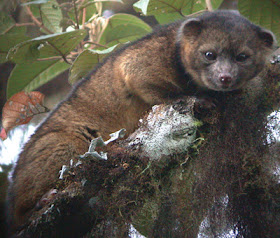If you follow any sort of science news site, especially if you read the zoology bits, you cannot have failed to notice the recent announcement of the discovery of a "new species of carnivore" in South America. By the standards of such things, its a major news story - the last time this happened in the New World was in 1978, when the Colombian weasel was discovered. In addition to the news coverage, the original announcement is available to read (all 83 pages of it), free online, for anyone who cares to. There's probably not a lot I can add to all that.
Still, I feel that it's not something I should really ignore, so here's my take on it, and an attempt to put the discovery into some sort of context.
Let's start with the obvious: what is this new animal, exactly? The olinguito (Bassaricyon neblina) is a newly described species of olingo. Which may, in many people's minds, raise the question: "um... what's an olingo?"
Olingos are long-tailed, tree-dwelling, members of the raccoon family, found in the jungles of Central and South America. They were first scientifically described, as a group, by the American zoologist J.A. Allen in 1876, which is itself remarkably late (all the other main groups within the family had been discovered by 1830, and most of them well before that). They've never been seen to eat anything but fruit and flowers, although it's suspected that they also snack on the occasional passing insect.
Pages
▼
Sunday, 25 August 2013
Sunday, 18 August 2013
Caprines: Goats of the Shadowed Cliffs
 |
| Himalayan goral |
In the case of the goats, the species that have probably changed the least from the ancestral form are the serows and gorals of eastern Asia. Both kinds of animal have retained a "resource defender" lifestyle, where they find patches of lush food in the otherwise rocky wastes of precipitous cliffs and mountainsides, and defend them from all comers.
Sunday, 11 August 2013
Pleistocene (Pt 10): Of Armadillos and Bison
 |
| Glyptotherium |
But they weren't alone, and not necessarily any stranger than some of their fellow immigrants. The same event that saw the arrival of the ground sloths also saw the coming of the armadillos. Today, there is only one species of armadillo in the United States, and only two outside of South America (the other gets no further north than southern Mexico). But, back during the Pleistocene, there were others, and some of them were not quite what we'd expect today.
Sunday, 4 August 2013
Leopard Cubs: The Struggle to Survive
It's obviously important to know, for conservation purposes, how populations of animals are changing. Are they increasing, or decreasing, and how rapidly? A clear factor in determining this is working out how many of them are dying, and ideally, what they are dying of. But we also need to know how many are being born, how often this happens, how likely they are to reach adulthood and have children of their own, and other factors more to do with birth than with death.
Probably the best way to really get a grip on births in an animal population is to study it for several generations, seeing what changes and when, and what factors are particularly important for infant survival. For the majority of small mammal species, a generation isn't a very long time, so it's practical to do that - although the sheer number of such species inevitably means that the great majority have never been studied. For larger, longer lived, animals, its a different matter, and the task can be far more difficult.
Probably the best way to really get a grip on births in an animal population is to study it for several generations, seeing what changes and when, and what factors are particularly important for infant survival. For the majority of small mammal species, a generation isn't a very long time, so it's practical to do that - although the sheer number of such species inevitably means that the great majority have never been studied. For larger, longer lived, animals, its a different matter, and the task can be far more difficult.

